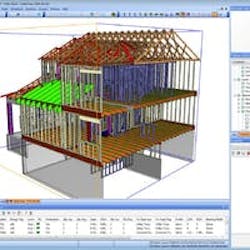Savvy Homes, a production-custom home builder, started 450 homes in 2012, up from 289 in 2011 when the company earned $70 million in revenue. Today, Savvy Homes builds in 31 communities, constructing homes up to 3,200 square feet and using 40 total home plans. With extremely lean operations, the company focuses on cost control and recently enacted its most dramatic cost-saving initiative ever: switching from stick-framed roofs to roof trusses.
It might seem odd for a production-custom home builder to adopt roof trusses over sticks, but trusses actually offer dramatic flexibility in custom design; moreover, today’s truss-design software (like MiTek’s SAPPHIRE Suite) offers a remarkable ability to accommodate structural changes and even last-minute options.
The results of this stick-to-truss conversion are nothing short of dramatic.
“Just with what we are saving in roof framing time, we are able to cut our overall framing time by 50 percent,” says George Aiken, Savvy Homes co-founder. “Plus, we are also running smaller crews above the sill. They are spending less time above ground — lowering our risk — and we’ve eliminated two cut-guys down low, which you need when you’re stick framing. Also, we don’t have material hanging around the jobsite, lowering our damage and theft. Trusses get delivered and we set them right away.
“With trusses, building the roof is more like putting the pieces of a puzzle together because the engineering has already been done offsite by the component manufacturer,” Aiken explains. For manufacturing, Savvy Homes relies on multiple component manufacturers (CMs) including Stock, Builders FirstSource, and ProBuild, all of which are MiTek shops.
“For our conversion to trusses, we are currently focused on trusses above the top plate, and it’s taught us some instructive lessons, all of which confirm our decisions," Aiken says. "First, trusses require a lower level of overall supervision. They are quicker to install than rafters. That’s obvious, but keep in mind that you are piecing together a roof system that’s already been configured. You are not framing the roof from scratch each time. Plus, when setting trusses, we can choose from several framers and not be tied to a high-priced custom roof framer. There is a labor shortage of these highly skilled guys anyway, so it’s best if we can manage without them.
“There’s another benefit to trusses,” Aiken continues, revealing the true structural engineer within. “We use CAD and framing-design software with our component manufacturer that gives us a 3-D view of the home and its actual structural framing, before it is built on site. So, at a glance, we can understand where the load paths are and where the uplift is, yet we don’t have to dig through 30 pages of truss profiles to determine that.”
